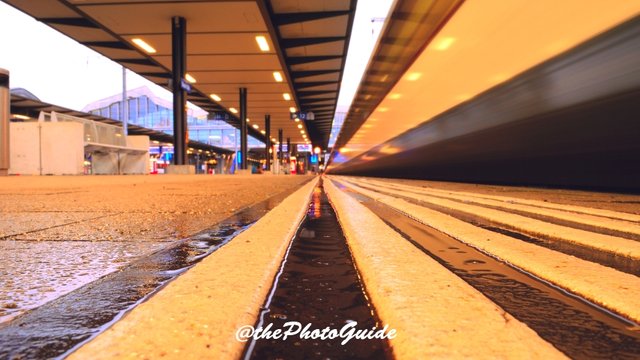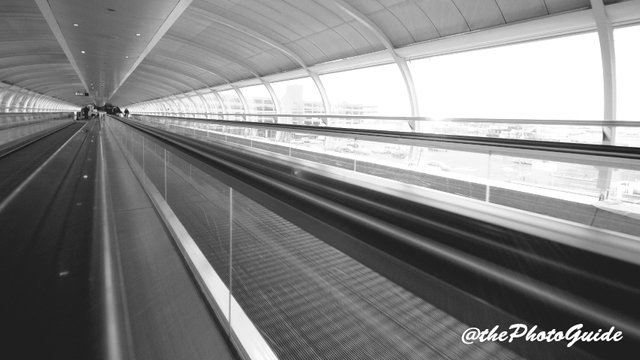Composition in Photography - using leading lines to determine your own perspective
Composition is one of the major pillars of photography. It is one of the most invisible yet noticable things that can make or break an image with its presence or lack of it.
Although it can be taught, you need to have a trained eye and feeling for it to get it right without having to think about it. Compare it to parking a car, some people just do it without thinking while others need years of practice and still might not get it right.
 This photo was taken at the Manchester airport, England.
This photo was taken at the Manchester airport, England.
2d or 3d?
We live a in 3 dimensional world and our eyes allow us to see depth and distance which tells us exactly how far an object is away. In photography, that is a little harder because no matter on what medium you look at it, it is still a flat surface. In photography a 3d effect can be accomplished by Depth of Field or using perspective.
Perspective
There are several elements that make up your perspective, naming:
1. Viewpoint
2. Horizon
3. Vanishing point
Viewpoint
The viewpoint is the position of your eyes where you view the subject from. You could go really high in the sky for a birds-eye-view, for example from a drone. You could have a standing viewpoint where you take the photo using the same viewpoint we see everything when walking around. There is also the worms-eye-view, when you literally go to the ground and view the world as if you were...a worm. This is actually a favorite viewpoint of mine because it gives a photo a unique perspective. How often do you lay on the ground just to look at the world? Not very often I think. Usually I go somewhere in between by just bending my knees and squatting down.
 I love trainstations and airports to get these kinds of shots, like here at the trainstation of Basel, Switzerland.
I love trainstations and airports to get these kinds of shots, like here at the trainstation of Basel, Switzerland.
Horizon
The horizon is basically the end of the earth...considering the earth isn't flat but round, there is a limitation as to how far we can see. That end, where the sky borders the ground is called the horizon. Now depending on your viewpoint, the horizon could be high or low. Depending on what your subject is, I usually advice to keep the horizon in the middle of your photo. That way you keep the balance between the sky and the earth. Again, it depends on what you want to focus on.
Vanishing point
The vanishing point is basically the point your eyes are being led to. This the true pillar of perspective. This can be reached by using leading lines. These could be natural or linear (usually man made). The wider your focal point (100mm being long, 10mm being wide), the more effective these lines will be. Most landscape photography leans on this principle, usually using natural lines like rivers, hedges or whatever is usable.
By definition the vanishing point is the point your eyes can no longer see in the distance. This point is located on the horizon, that's why it's so important to know where your horizon is. The converging lines will lead you to the vanishing point. Alternatively, painters or other artists turn it around and determine their own vanishing point to draw their perspective lines from.
Placement of the vanishing point
I don't take a lot of landscape photos of natural situations. I do however love to apply the same rules of composition in more architectural type of photos heavily leaning on linear lines. Because I love symmetry, I usually place my vantage point in the middle with the horizontal and vertical lines meeting in the exact middle. Using different viewpoints and a little wide angle distortion I try to create my own unique perspective. Sometimes even deliberately tilting the horizon to make it personal. You can see examples of that in a previous post.
Also not placing the vanishing point in the middle can give a very different effect to the photo. Even choosing a different horizon can change things up. Like I did here. It's the same location as the one above, only very different.
 Do you still recognize this scene?
Do you still recognize this scene?
Wide angle distortion
Like I mentioned, using a wide angle lens can help you get very effective lines. You need to keep in mind though that the wider the focal point, the more distorted the view can get. Even a very wide 10mm lens won't give you the extremely distorted fish-eye view, but it can still twist and turn the straightest of lines. This can either add or diminish the feeling you want to create with your image so think beforehand what you are trying to accomplish when deciding which lenses you want to bring.

Follow me for lots more to come!
Great shots and an excellent tutorial. Many don't realize that we use the same guidelines in photography as artists have used in paintings for hundreds of years. Yes, beauty is in the eye of the beholder, but often the beholder has no idea why a photograph is so compelling; they just know it is!
Yes I did some research for this post and it went all the way back to the 15th century! That's why I'm trying to teach people with these posts, how they can achieve certain results and why it enhances the overall image when using certain techniques
Great post! Great reminder to think outside the box. Will keep vanishing point in mind if I had an opportunity to use it.
Thank you so much! And yes...there is often one to be found even if it's not a very obvious one... even if there's only one line of perspective
I took one 4 hour class on my iphone and I sound like I know what I'm doing. lol I have lots to learn. I'm excited because I ditched my iphone and got an awesome pixel. So, camera is much better. I will be checking in on you on a regular basis for sure. :)
Oh yes! An actual camera is way better! So much more options and possibilities...and when you get that perfect shot you will actually be able to put it to use thanks to the better quality. Would be great to see you checking in!
Well, the Google Pixel is an android but hey, it's better than my iphone! lol It's a HUGE step up in quality of photos. :)
Oh right i misread there...but still if it gives you better photos thats a step in the right direction!
Hi @thephotoguide... I gave you props in my last post because of vanishing point. :) You'll be so proud!
This post has received a 1.37 % upvote from @booster thanks to: @thephotoguide.
This post got a
2.04% upvote thanks to @thephotoguide - Hail Eris !Awesome Pictures! Thank you for sharing with us
Upvoted & Followed @thephotoguide